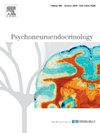The interplay of depressive symptoms, adiposity, and metabolic markers in young adults
IF 3.6
2区 医学
Q2 ENDOCRINOLOGY & METABOLISM
引用次数: 0
Abstract
Background
Depression is associated with increased adiposity, and insulin resistance (IR) and leptin have been proposed as potential mediators of this relationship. However, the exact nature of this relationship is poorly understood in young adults. Therefore, we investigated the relationship of total depressive symptom severity and specific depressive symptom clusters with adiposity and metabolic markers in young South African adults.
Methods
We stratified 997 adults (aged 20–30 years) according to increasing body mass index (BMI) and waist-to-height-ratio (WHtR) categories. The Patient Health Questionnaire (PHQ-9) was used to assess total depressive symptom severity, somatic- and cognitive-affective depressive symptom cluster scores. Leptin, insulin, and glucose were measured using fasting blood samples. The homeostatic model assessment for IR (HOMA-IR) was calculated.
Results
After adjustment for confounders, leptin, insulin, glucose, and HOMA-IR were higher across increasing BMI and WHtR categories (all p < 0.001). The PHQ-9 total score was positively associated with BMI in BMI-stratified overweight and obese adults (all p ≤ 0.025). Reciprocal associations between the PHQ-9 total score and WHtR were absent in all WHtR groups. The PHQ-9 total score was positively associated with leptin in WHtR-stratified normal weight adults (p = 0.005) and with HOMA-IR in WHtR-stratified underweight and BMI-stratified normal weight adults (all p ≤ 0.029). Independent of adiposity status, the PHQ-9 total score was positively associated with insulin (all p = 0.026). Associations with the PHQ-9 total score were mainly driven by the somatic-affective symptom cluster. Somatic-affective symptoms were also inversely associated with fasting glucose in BMI-stratified underweight adults (p = 0.008).
Conclusion
In young apparently healthy adults, general adiposity is linked to greater total depressive symptom severity and somatic-affective depressive symptoms. Insulin might play a role in pathophysiological processes associated with depressive symptoms, irrespective of adiposity status, while fasting glucose and HOMA-IR may play a role in underweight individuals.
年轻人抑郁症状、肥胖和代谢标志物的相互作用
抑郁症与肥胖增加有关,胰岛素抵抗(IR)和瘦素被认为是这一关系的潜在中介。然而,这种关系的确切性质在年轻人中却知之甚少。因此,我们调查了南非年轻成年人的总体抑郁症状严重程度和特定抑郁症状群与肥胖和代谢标志物的关系。方法按体重指数(BMI)和腰高比(WHtR)分类对997例20 ~ 30岁成人进行分层。采用患者健康问卷(PHQ-9)评估总体抑郁症状严重程度、躯体和认知情感抑郁症状聚类得分。使用空腹血液样本测量瘦素、胰岛素和葡萄糖。计算IR的稳态模型评估(HOMA-IR)。调整混杂因素后,瘦素、胰岛素、葡萄糖和HOMA-IR在BMI和WHtR增加的类别中较高(p均为 <; 0.001)。BMI分层超重和肥胖成人的PHQ-9总分与BMI呈正相关(均p ≤ 0.025)。在所有WHtR组中,PHQ-9总分与WHtR之间没有相互关联。PHQ-9总分与whtr分层正常体重成人瘦素呈正相关(p = 0.005),与whtr分层体重过轻和bmi分层正常体重成人HOMA-IR呈正相关(p ≤ 0.029)。与肥胖状况无关,PHQ-9总分与胰岛素呈正相关(p均 = 0.026)。与PHQ-9总分的关联主要由躯体-情感症状群驱动。在bmi分层体重过轻的成年人中,躯体情感症状也与空腹血糖呈负相关(p = 0.008)。结论在表面健康的年轻成年人中,一般肥胖与更大的总抑郁症状严重程度和躯体情感性抑郁症状有关。胰岛素可能在与抑郁症状相关的病理生理过程中发挥作用,而与肥胖状态无关,而空腹血糖和HOMA-IR可能在体重过轻的个体中发挥作用。
本文章由计算机程序翻译,如有差异,请以英文原文为准。
求助全文
约1分钟内获得全文
求助全文
来源期刊

Psychoneuroendocrinology
医学-精神病学
CiteScore
7.40
自引率
8.10%
发文量
268
审稿时长
66 days
期刊介绍:
Psychoneuroendocrinology publishes papers dealing with the interrelated disciplines of psychology, neurobiology, endocrinology, immunology, neurology, and psychiatry, with an emphasis on multidisciplinary studies aiming at integrating these disciplines in terms of either basic research or clinical implications. One of the main goals is to understand how a variety of psychobiological factors interact in the expression of the stress response as it relates to the development and/or maintenance of neuropsychiatric illnesses.
 求助内容:
求助内容: 应助结果提醒方式:
应助结果提醒方式:


